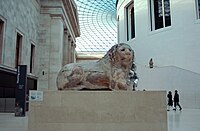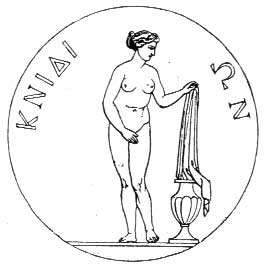Knidos
Κνίδος (in Ancient Greek) | |
 The port of Knidos | |
| Alternative name | Cnidus |
|---|---|
| Location | Yazıköy, Muğla Province, Turkey |
| Region | Caria |
| Coordinates | 36°41′09″N 27°22′30″E / 36.68583°N 27.37500°E |
| History | |
| Associated with | Eudoxus, Ctesias, Sostratus |
| Events | Battle of Cnidus |
| Site notes | |
| Excavation dates | 1857–1858 |
| Archaeologists | Charles Thomas Newton |
| Public access | Yes |
| Website | Knidos Archaeological Site |
Knidos or Cnidus
It was built partly on the mainland and partly on the Island of Triopion or Cape Krio. The debate about it being an island or cape is caused by the fact that in ancient times it was connected to the mainland by a causeway and bridge. Today the connection is formed by a narrow sandy isthmus. By means of the causeway the channel between island and mainland was formed into two harbours, of which the larger, or southern, was further enclosed by two strongly built moles that are still in good part entire.[2]
The extreme length of the city was little less than a mile, and the whole intramural area is still thickly strewn with architectural remains. The walls, both of the island and on the mainland, can be traced throughout their whole circuit; and in many places, especially round the acropolis, at the northeast corner of the city, they are remarkably perfect.[2]
History

Antiquity
Knidos was a Hellenic city of high antiquity. According to
The city was at first governed by an
In their expansion into the region, the Romans easily obtained the allegiance of Knidians, and rewarded them for help given against Antiochus III the Great by leaving them the freedom of their city.[2]
Byzantine era
During the Byzantine period there must still have been a considerable population: for the ruins contain a large number of buildings belonging to the Byzantine style, and Christian sepulchres are common in the neighbourhood.[2]
Bishop Ioannes of Cnidus took part in the

Excavation history
The first Western knowledge of the modern site was due to the mission of the

The agora, the theatre, an odeum, a temple of Dionysus, a temple of the Muses, a temple of Aphrodite[10] and a great number of minor buildings have been identified, and the general plan of the city has been very clearly made out. The most famous statue by Praxiteles, the Aphrodite of Knidos, was made for Cnidus. It has perished, but late copies exist, of which the most faithful is in the Vatican Museums.[2]

In a temple enclosure Newton discovered the fine seated statue of
In 2022, the low tide revealed ruins of an ancient port near the site which is believed to have been the port of Knidos.[11]

See also
Notes
- ^ EB 1878, p. 44.
- ^ a b c d e f g h i j k EB 1911, pp. 573–374.
- ISBN 0-19-927648-X cited text
- ^ British Museum Collection
- ^ Duncker, Maximillian Wolfgang, History of Greece: From the Earliest Times to the End of the Persian War, S.F. Alleyne, trans., London: Richard Bentley & Son, 1883.
- .
- ^ Michel Lequien, Oriens christianus in quatuor Patriarchatus digestus, Paris 1740, Vol. I, coll. 917-918
- ^ Raymond Janin, v. Cnide, in Dictionnaire d'Histoire et de Géographie ecclésiastiques, vol. XIII, Paris 1956, col. 179
- ISBN 978-88-209-9070-1), p. 872
- from the original on 2022-01-12. Retrieved 2021-06-18.
- ^ Low tide reveals ruins of ancient port near Knidos
References
- Baynes, T. S., ed. (1878), , Encyclopædia Britannica, vol. 6 (9th ed.), New York: Charles Scribner's Sons, p. 44
- This article incorporates text from a publication now in the public domain: Chisholm, Hugh, ed. (1911), "Cnidus", Encyclopædia Britannica, vol. 6 (11th ed.), Cambridge University Press, pp. 573–4

